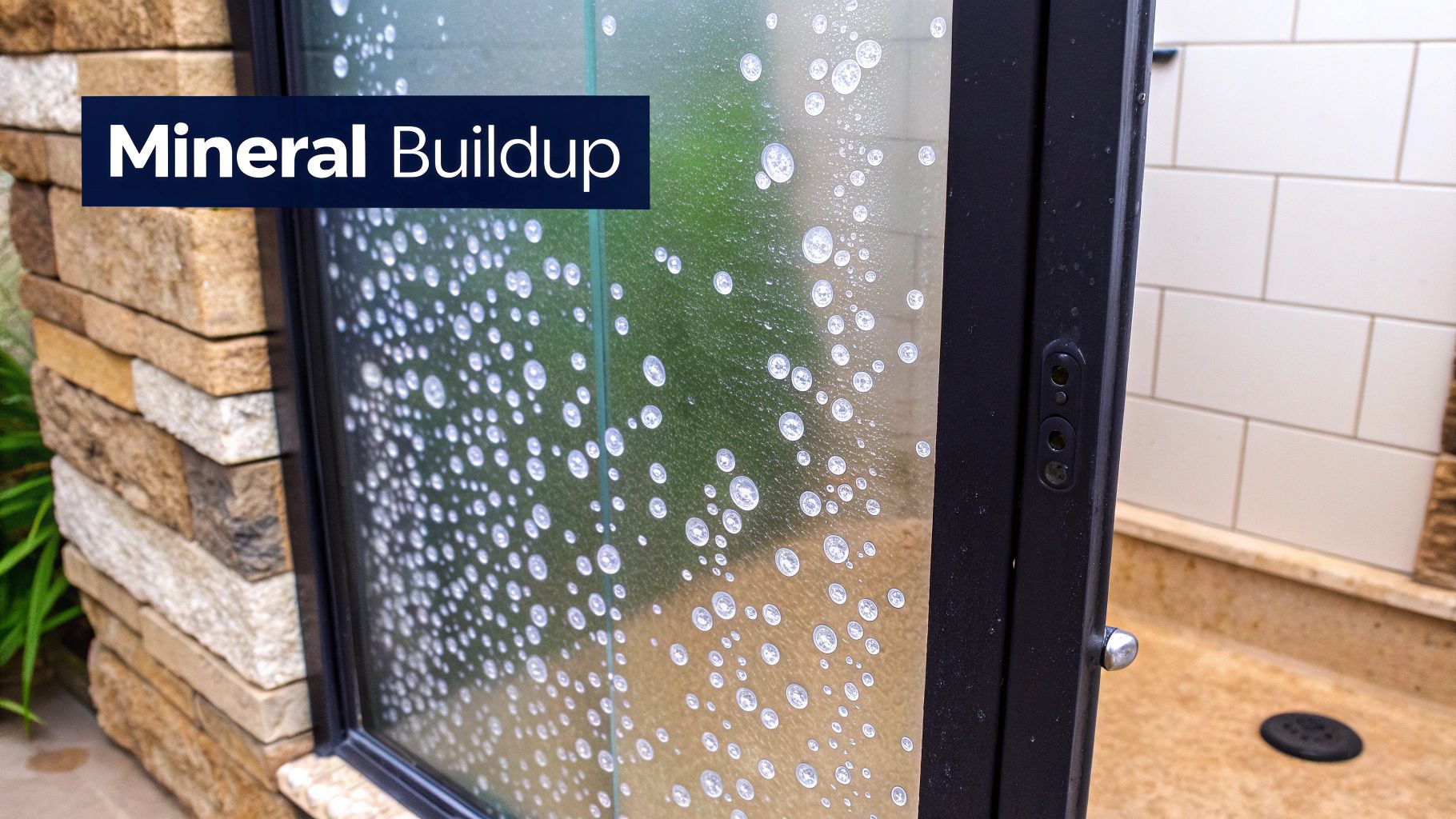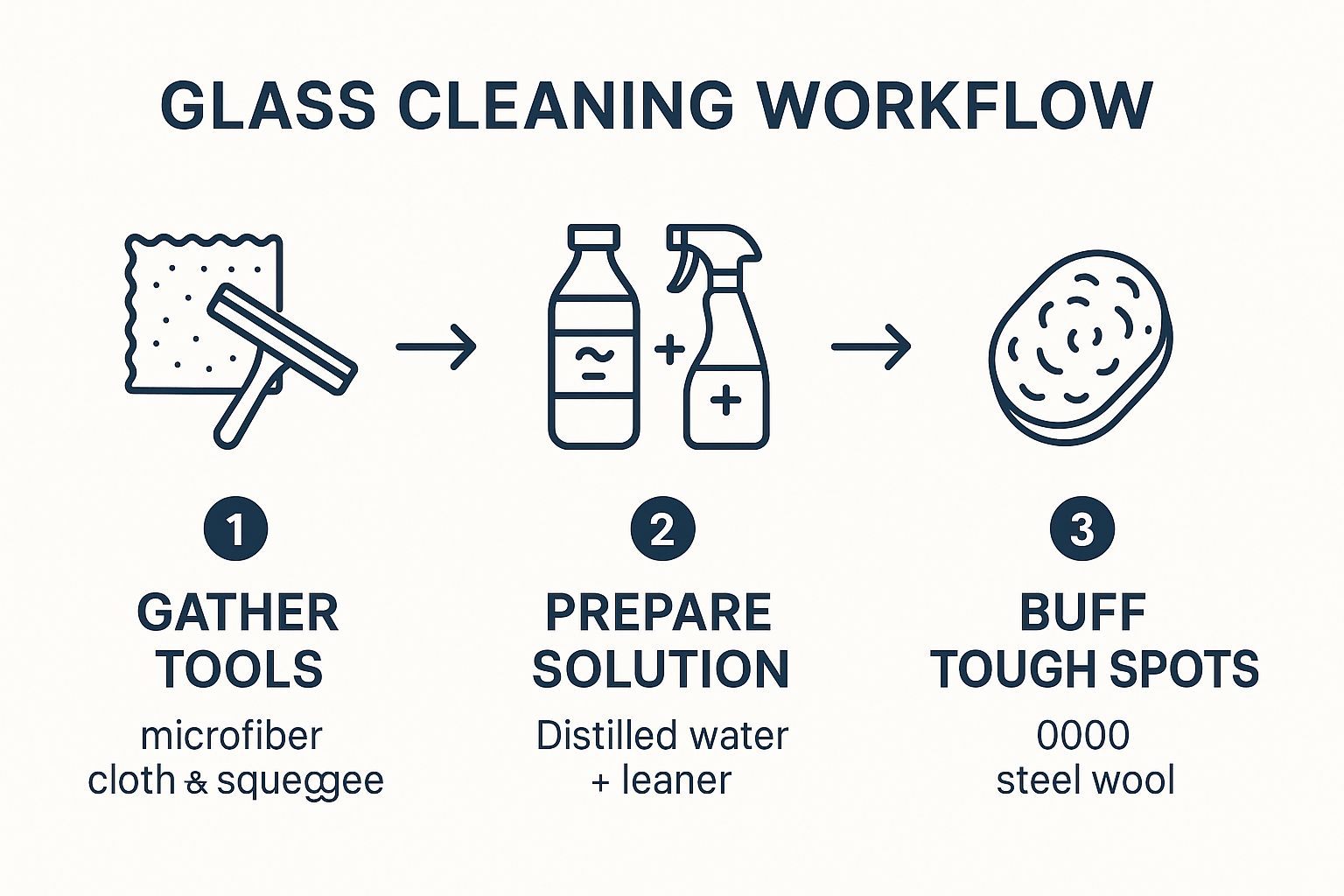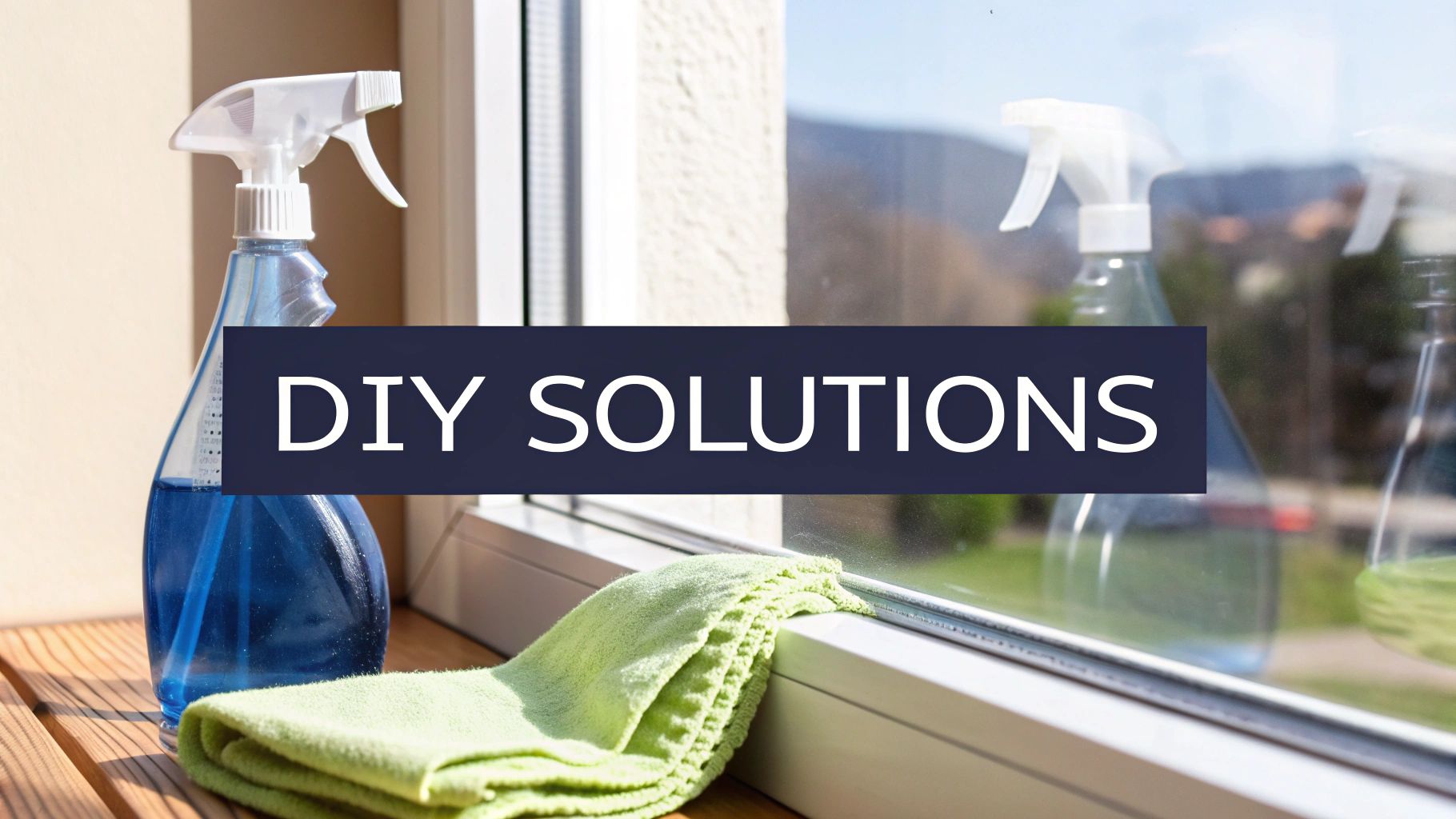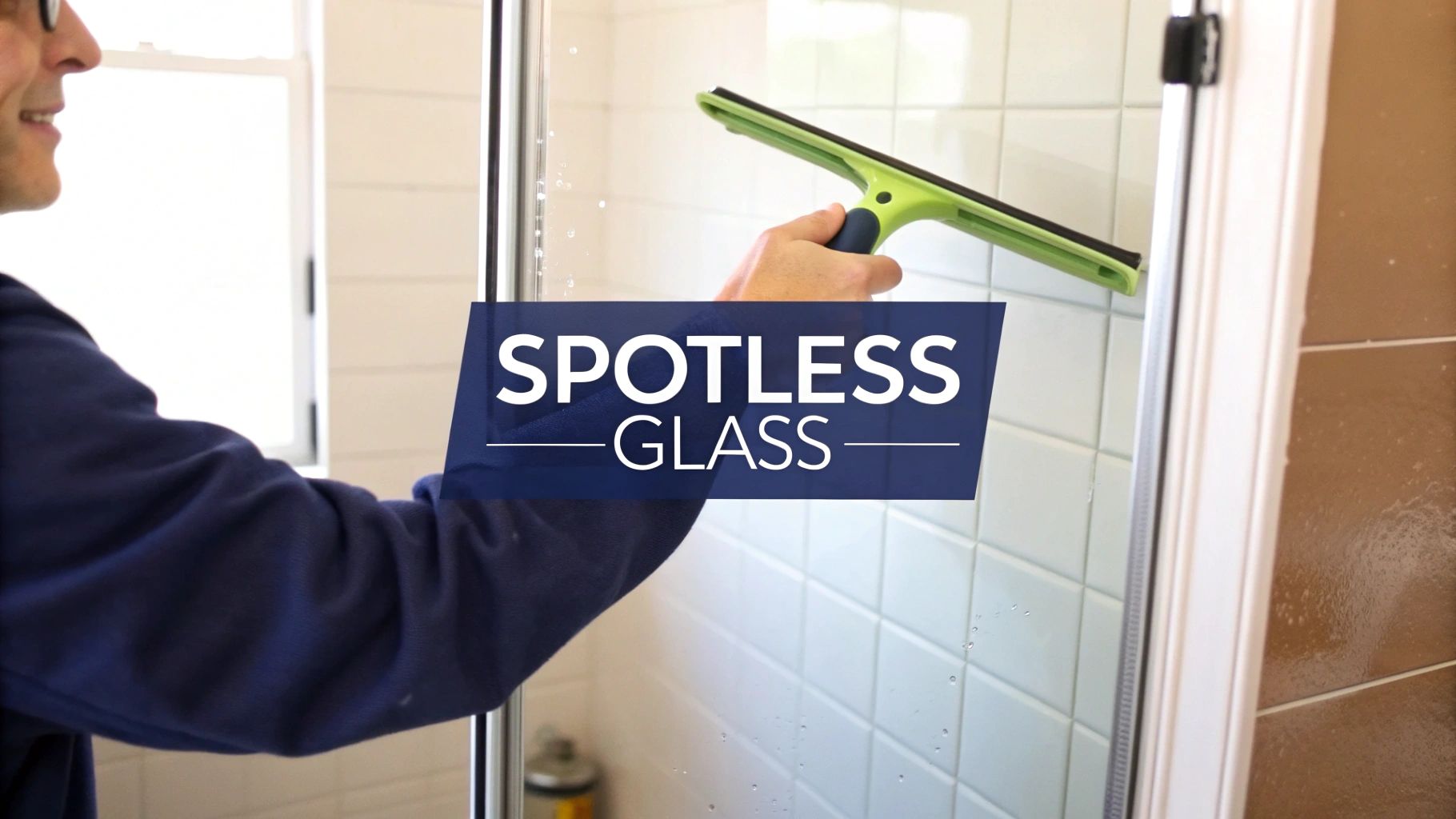If you want to get rid of water spots for good, you need something that will dissolve mineral deposits, not just a standard glass cleaner. For most light stains, a simple mix of equal parts white vinegar and water is a brilliant place to start. The acid in the vinegar is fantastic at chemically breaking down the stubborn calcium and magnesium that get left behind when water dries.
Why Stubborn Water Spots Form on Your Glass

Before you grab a cloth and start scrubbing, it helps to know what you’re up against. Those cloudy, chalky marks on your shower screen or car windows aren't just dried water. They're mineral deposits—mostly calcium and magnesium—that have been left on the surface after the water itself has evaporated.
This is a really common problem for households all over the UK, especially in hard water regions. If you live somewhere like the South East, you'll know all about the high mineral content in the tap water, which leads to tougher, more frequent water spots.
The Science Behind the Stains
So, what's actually happening? When a droplet of water dries on glass, the H₂O evaporates, but the minerals it was carrying are left behind. These deposits then start to bond with the silicon dioxide in the glass itself, creating a tough layer that a simple wet cloth just can’t shift. Over time, this process, known as etching, can get worse and even cause permanent damage if you don't tackle it.
This is exactly why you need a cleaning method that can properly dissolve those mineral bonds. A popular home remedy is that simple white vinegar and water solution. The acetic acid in the vinegar is the key ingredient, as it chemically breaks down the alkaline mineral deposits. You can always learn more about tackling hard water stains at home if you want to get into the nitty-gritty.
Understanding this simple bit of science is the key. It makes it clear why you need a specific solution to dissolve the minerals, not just clean the surface, if you want to get your glass spotless again.
Common Places Water Spots Appear
You'll find these frustrating marks on just about any glass surface that gets wet regularly. Some of the usual suspects include:
- Shower Screens and Doors: Being constantly sprayed with water makes these a prime spot for mineral build-up.
- Exterior Windows: Rainwater isn't pure. It can pick up pollutants and minerals that stain the glass as it dries.
- Car Glass: Whether it’s from road spray or a quick rinse with the hosepipe, water left to dry on your car will almost certainly leave spots.
- Glass Balustrades: Outdoor glass panels are always exposed to the elements, making staining pretty much inevitable.
Your Essential Glass Cleaning Toolkit
When you're learning how to get rid of those annoying water spots on glass, having the right gear is half the battle. A well-prepared toolkit can turn a frustrating job into a surprisingly satisfying one, leaving you with a flawless, professional-looking finish every single time. It’s not just about grabbing any old cloth and spray; it’s about having the right tool for each stage of the process.
For starters, your basic set-up should always include a couple of high-quality, lint-free microfibre cloths—one for the actual cleaning and a separate one for drying and buffing. You'll also need a decent spray bottle. But here's the real game-changer that professionals swear by: using mineral-free water for the final rinse. Using deionised or distilled water prevents new spots from forming as the surface dries, as there's absolutely no residue left behind. If you're curious about the science behind it, you can learn more about how pure water systems work and why it delivers a perfect finish.
Core and Specialised Equipment
Dealing with large glass surfaces like patio doors or big picture windows? A quality rubber squeegee is an absolute must-have. It lets you clear the cleaning solution away in one clean, smooth pass. Trust me, it’s far more effective than just wiping with a cloth and is your best defence against streaks.
Sometimes, though, you come across those truly stubborn, etched-in water spots that just won't budge. For these, you might need to bring out the heavy hitters. A pad of ultra-fine 0000-grade steel wool is a professional's trick for carefully buffing away baked-on mineral deposits without scratching the glass. The key is to always use it wet, with plenty of your cleaning solution as a lubricant. Never use it dry.
This infographic breaks down a simple workflow, from getting your basic tools together to tackling those tougher spots.

The main takeaway here is that your approach should be scalable. You start with the basics for everyday cleaning and only introduce specialised tools like steel wool when you're faced with really severe staining.
Effective Homemade Solutions That Actually Work

Before you head out to buy a specialist cleaner, take a look in your kitchen cupboards. Some of the best weapons against water spots are everyday household items, offering a brilliantly simple and budget-friendly way to get your glass gleaming again.
These DIY fixes are popular for a reason—they work. The magic is in their chemistry. Common ingredients like vinegar and bicarbonate of soda either dissolve the mineral deposits or gently scrub them away, tackling the root cause of those cloudy marks on your windows and shower screens.
The White Vinegar Method
When it comes to homemade glass cleaners, white vinegar is the undisputed champion. It’s the acetic acid that does all the heavy lifting, effortlessly breaking down the alkaline mineral deposits left behind by hard water.
Creating your own powerful spray couldn't be easier.
- Start by mixing equal parts white vinegar and distilled water in a clean spray bottle. It's really important to use distilled water here to prevent leaving fresh mineral spots behind as the glass dries.
- Spray the solution liberally over the affected glass, making sure you cover every last stain.
- Now for the important bit: let it sit for a good 10-15 minutes. This dwell time is non-negotiable, as it gives the acid the time it needs to dissolve those stubborn minerals.
- Once the time is up, give the area a gentle scrub with a non-abrasive sponge or microfibre cloth, working in small circles. Finish by rinsing with clean water and drying completely with a squeegee or a fresh cloth for a streak-free finish.
Pro Tip: For really tough, baked-on marks, try gently warming the vinegar in the microwave before you mix it. A little warmth can supercharge the chemical reaction, helping the minerals break down much faster.
Using a Bicarbonate of Soda Paste
If you're dealing with more stubborn, layered stains—the kind you often find on shower doors—you might need a bit more muscle. This is where a mild abrasive comes in handy. A simple paste made from bicarbonate of soda is perfect, as it gives you the scrubbing power to lift stains without any risk of scratching the glass. In fact, many proven methods for cleaning glass shower doors rely on simple ingredients like this for fantastic results.
To make it, just mix bicarbonate of soda with a small amount of water until you have a thick paste, almost like toothpaste. Apply it directly to the water spots, let it sit for a few minutes, and then use a damp cloth to gently scrub the marks away before rinsing everything off.
Advanced Techniques for Severe Water Stains
Sometimes, a simple homemade solution just won't make a dent. When you're faced with severe, deeply etched water spots that have been there for months—or even years—it’s time to bring out the bigger guns. This means moving beyond a simple acidic spray to a combination of chemical power and gentle physical abrasion.
Don't worry, these methods might sound intense, but they are perfectly safe to use at home. You just need to follow the right steps to restore your glass without causing any damage.
Using 0000-Grade Steel Wool
For those really stubborn mineral deposits, one of the best-kept secrets of the trade is 0000-grade steel wool. It sounds counter-intuitive, I know, but this technique has been a trusted staple for professional window cleaners in the UK for about a century. It's prized for its ability to gently lift mineral build-up without scratching the glass surface. You can actually discover more about this traditional method and see why it's been so successful for so long.
To get it right, just follow these simple guidelines:
- Always use it wet. Never, ever use it dry. Give the glass a generous spray with your cleaning solution or even just plain water to create a lubricant.
- Gentle pressure is key. Let the fine steel wool do the work. There's no need to scrub hard. Just use light, even pressure in small, circular motions over the stained area.
- Do a patch test first. If you're feeling a bit nervous, find an inconspicuous corner and test it out. This will give you confidence in the process and the results before tackling the main area.
Choosing a Commercial Water Spot Remover
If you'd rather stick to a chemical solution, specialised commercial removers are your next best bet. These formulas are specifically engineered with stronger acids or fine abrasives to dissolve the kind of heavy mineral deposits that your kitchen vinegar simply can't handle.
What you're looking for are products with active ingredients like mild phosphoric acid or cerium oxide. They create a different chemical reaction to the acetic acid in vinegar, giving you that extra oomph needed for severe stains. It's what the pros often turn to for guaranteed results, which is why exploring professional glass cleaning services can be a great option for the absolute toughest jobs.
When you've got your product, always follow the manufacturer's instructions to the letter. This usually involves applying it with a microfibre pad and then buffing away the residue with a separate, clean cloth.
Keeping Your Glass Spotless for Longer

You’ve put in the elbow grease to get your glass looking pristine, so the last thing you want is for those stubborn water spots to reappear. The secret isn't just cleaning; it's about shifting your mindset from reactive scrubbing to proactive prevention.
A few simple changes to your routine can stop those mineral deposits from ever taking hold. It’s a classic case of prevention being better than the cure, and it will save you a ton of time and effort down the line.
Smart Daily Habits
The most powerful weapon against water spots is getting rid of the water before it evaporates. It sounds almost too simple, but turning this into a daily habit, especially for shower doors, makes all the difference.
- The Two-Minute Squeegee Routine: Hang a squeegee in your shower and get into the habit of wiping down the glass after every use. Just a few quick swipes will remove most of the water droplets, stopping mineral residue in its tracks.
- Dry with a Microfibre Cloth: For any lingering moisture, a quick buff with a clean microfibre cloth finishes the job, leaving the surface perfectly dry and streak-free.
These small daily actions are your first line of defence. They physically remove the hard water before its mineral content—the root cause of the problem—can bond to the glass.
Long-Term Prevention Strategies
If you want a more hands-off solution, you can treat your glass so it actively repels water. Applying a hydrophobic glass sealant, available at most motoring or home improvement shops, creates an invisible barrier. This causes water to bead up and roll straight off, taking the pesky minerals with it.
Of course, for anyone living in a hard water area, the ultimate fix is to tackle the problem at its source. To really get ahead of water spots, you might want to look at a detailed guide on whole house water filtration systems. These systems remove minerals like calcium and magnesium from your entire water supply.
This means that the water you use for everything, from showering to professional exterior window cleaning, is already soft. It makes spot formation almost impossible from the get-go.
Still Puzzling Over Water Spots?
Even when you follow the steps perfectly, some tricky situations can pop up. Let's tackle a couple of the most common questions I get asked about getting glass spotless.
Will Vinegar Harm My Car's Paint or Window Seals?
This is a great question and something you absolutely need to be mindful of. While a vinegar solution is a go-to for many cleaning jobs, its acidic nature requires a bit of care.
If you're working on your car's windows, avoid letting the vinegar solution drip and dry on the paint. Over time, repeated exposure can start to dull the clear coat. The same goes for the rubber seals around your windows, both on cars and at home. Acid can make them brittle with prolonged contact.
The pro tip here? Spray the cleaning solution onto your cloth, not directly onto the glass. This simple change gives you total control, keeping the vinegar exactly where you need it and away from any sensitive materials.
Is it Just a Stubborn Stain, or Has the Glass Been Etched?
It's easy to confuse the two, but the difference is critical. A water spot is just a mineral deposit sitting on top of the glass. Etching, on the other hand, is when those minerals have physically started to eat into the glass surface, causing permanent damage.
Here's a quick way to tell what you're dealing with. After you've cleaned the area as best you can, run your fingernail gently across the mark. If the glass feels perfectly smooth, you’re likely dealing with a very stubborn mineral stain that might need another go.
However, if you feel a slight roughness or a tiny dip under your nail, that's a sure sign of etching. Unfortunately, this kind of damage can't be fixed with cleaning products.
The real takeaway here is to act fast. The longer you leave mineral deposits sitting on glass, the higher the risk of them causing irreversible etching. Don't put it off!
For that flawless, streak-free finish that professionals demand, nothing beats pure water. At 24 Pure Water, our self-service filling stations across the country offer ultra-pure, deionised water whenever you need it. It's the secret to getting perfect results on any glass surface. Find your nearest filling station and see the difference for yourself.
